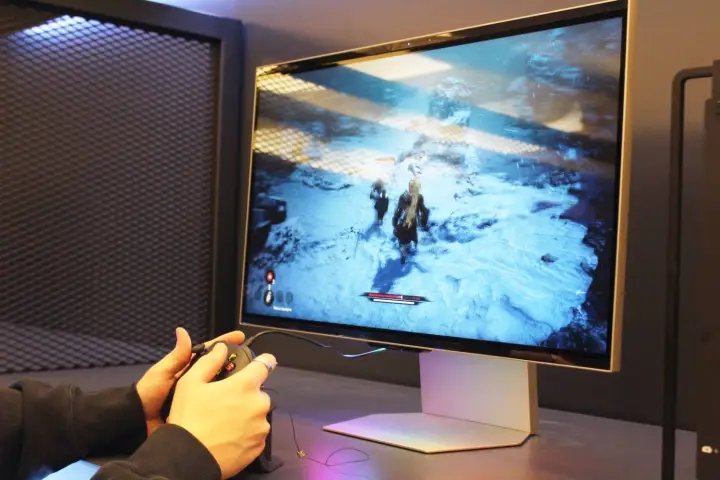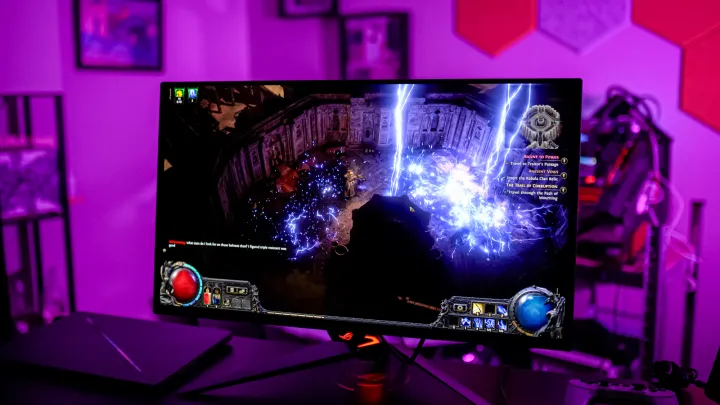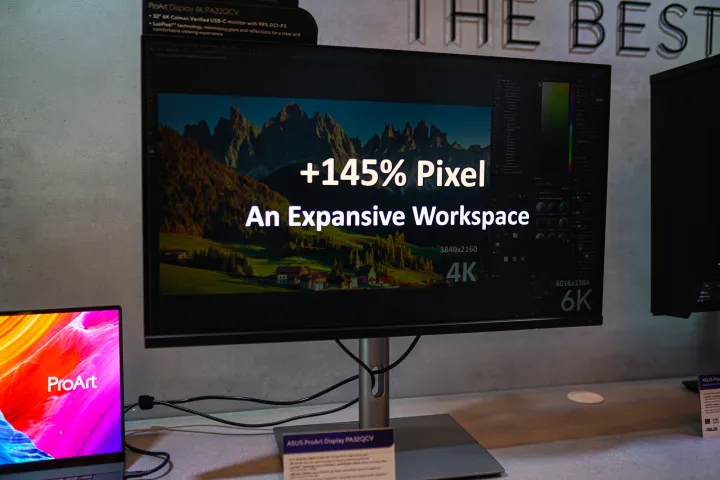
There are been a ton of monitors at CES 2025, but only a few really stood out to me. After visiting with dozens of companies, scouring the show floor, and permanently damaging my eyesight from staring at screens for hours on end, I’ve come up with the five best monitors I saw at CES 2025.
I have a mix here. Gaming monitors are usually the focus at CES, and there were plenty I saw that blew my mind this year. However, I’ve also included a couple of non-gaming picks, which usually don’t get the limelight they deserve.
Samsung Odyssey 3D

Glasses-free 3D has been an idea for years, but Samsung might be the first to actually pull it off with the Odyssey 3D. It’s not the first glasses-free 3D monitor, but it’s by far the best I’ve seen up to this point. The moment you sit down and start playing a game, you forget that you’re even playing on a 3D monitor — the display locks into place and doesn’t let go.
That’s been an issue with previous attempts like Acer’s SpatialLabs Predator 27. Although the 3D tech works, it works best in a fairly narrow sweet spot, forcing you to adjust your head until it’s just right. The Odyssey 3D doesn’t have that problem, despite using similar eye-tracking tech and a lenticular lens on the front panel to project two different images to each of your eyes. Samsung’s magic presumably comes through software — the tuning is just right.
Although the Odyssey 3D holds a lot of promise, it’s just promise for right now. The monitor can convert 2D content to 3D, but only through videos in full-screen mode in your web browser. On the game front, there’s only title with 3D support, but Samsung hopes to have at least 10 games ready by launch. In the future, the goal is to be able to automatically convert any 2D content to 3D, and if Samsung is able to pull that off with similar quality to what I saw at CES, that’s something to get excited about.
Asus ROG PG27UCDM

There’s one monitor that PC gamers have been begging for: a 27-inch OLED with a 4K resolution. Up this point, we’ve only seen OLED monitors at 27 inches climb to 1440p, such as with the LG UltraGear OLED 27, but now, you have have both the size and resolution you want with the Asus ROG PG27UCDM.
Asus isn’t the only one with this panel — MSI, Samsung, and Gigabyte all have their own takes — but Asus’ is the only one I’ve actually used. And it’s stunning. At 27 inches, the pixel density that a 4K resolution is unmatched, at least among gaming monitors, providing a tack-sharp image that’s only bolstered by the vibrant colors and deep contrast that the QD-OLED panel provides.
And the PG27UCDM goes beyond just packing an excellent panel. It includes a suite of OLED features that Asus has slowly been building over the past couple of years, including Black Frame Insertion and Asus’ new Neo Proximity Sensor, which detects when you’re sitting in front of the screen to automatically wake the monitor, and to put it to sleep when you step away.
MSI MPG 272QRF X36

MSI has a handful of monitors targeted at competitive gamers this year, including a display that boasts a 600Hz refresh rate, but the MPG 272QRF X36 takes the cake. It’s one of only a few monitors to debut Nvidia’s G-Sync Pulsar technology, which is already proving to be a vital tool for exceptional motion clarity in competitive games.
Pulsar is, essentially, dynamic backlight strobing. It allows the backlight to blank out between refreshes, only lighting up the screen when there’s a solid, static frame for you to see. The result is motion clarity that’s unmatched, even compared to OLED options with high refresh rates. You’re able to track objects throughout a scene with motion clarity equivalent to over 1,000Hz, and all while using variable refresh rate.
Nvidia’s Pulsar tech is the draw here, but this monitor is solid even outside of the new VRR tech. It’s a 27-inch display with a 1440p resolution, and it comes with a speedy 360Hz refresh rate.
Samsung Smart Monitor M9

I love a great gaming monitor as much as the next person, but non-gamers deserve cutting-edge display technology, too. And that’s exactly what the Samsung Smart Monitor M9 delivers. It’s a 32-inch 4K display with Samsung’s smart TV operating system, but critically, it’s packing an OLED panel.
It’s one of the first monitors to take OLED beyond a gaming display, and with a ton of features to make it useful regardless of if you have a supercharged PC to plug into it. In addition to a slew of streaming apps that are normally available through One UI, the display includes the Pro version of Samsung’s 4K AI upscaling, allowing you to enjoy the high pixel density of the display even if you aren’t viewing native 4K content.
Although the Smart Monitor M9 isn’t angled toward gamers, it can still do in a pinch. It’s a 4K display with the beautiful image quality of OLED, but it also comes with a solid 165Hz refresh rate if you want to play a few games.
Asus ProArt 6K PA32QCV

Asus has a very compelling monitor for content creators. The ProArt PA32QCV is a 32-inch display packing a 6K resolution — that’s 6,016 by 3,384. That high of a resolution makes it unmatched from a pixel-density perspective, providing a staggering 218 pixels per inch (PPI). For context, even most 4K monitors only offer a PPI around 130.
It’s incredibly sharp, and aimed at creators who need that high of a resolution for video editing, designing, and visual effects work. The resolution is certainly the draw, but the ProArt 6K still comes packed with DisplayHDR 600 certification and factory calibration, which Asus claims delivers a color error of less than 2 out of the box.
It’s sure to be an expensive display, but Asus hasn’t shared pricing or availability details quite yet.





